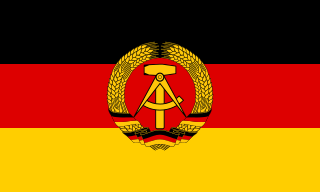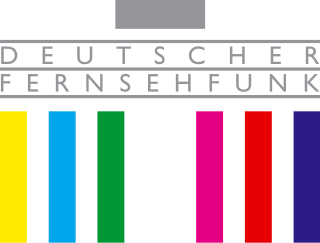
East Germany, officially known as the German Democratic Republic, was a country in Central Europe from its formation on 7 October 1949 until its reunification with West Germany on 3 October 1990. Until 1989, it was generally viewed as a communist state and described itself as a socialist "workers' and peasants' state". The economy of this country was centrally planned and state-owned. Although the GDR had to pay substantial war reparations to the Soviets, it became the most successful economy in the Eastern Bloc.

The Socialist Unity Party of Germany was the founding and ruling party of the German Democratic Republic from the country's foundation in 1949 until its dissolution after the Peaceful Revolution in 1989. It was a Marxist–Leninist communist party, established in 1946 as a merger of the East German branches of the Communist Party of Germany and Social Democratic Party of Germany.

Günter Schabowski was an East German politician who served as an official of the Socialist Unity Party of Germany, the ruling party during most of the existence of the German Democratic Republic (GDR). Schabowski gained worldwide fame in November 1989 when he improvised a slightly mistaken answer to a press conference question about the future of the Berlin Wall. That raised popular expectations much more rapidly than the government planned and so massive crowds gathered the same night at the Wall, which forced its opening after 28 years. Soon afterward, the entire inner German border was opened.
The National Front of the German Democratic Republic was officially an alliance of parties and mass organisations (1950–1990). In fact, only one party held power in the GDR, namely the communist SED. The National Front was an instrument to exercise control over the other parties and organisations. The precursor of the National Front was the Democratic Bloc.

The culture of East Germany varied throughout the years due to the political and historical events that took place in the 20th century, especially as a result of Nazism and Communism. A reflection on the history of arts and culture in East Germany reveals complex relationships between artists and the state, between oppositional and conformist art. In four decades, East Germany developed a distinct culture and produced works of literature, film, visual arts, music, and theatre of international acclaim. Popular culture specialities included among others a high popularity of nudism in Eastern Germany.

The Peaceful Revolution, as a part of the Revolutions of 1989, was the process of sociopolitical change that led to the opening of East Germany's borders with the West, the end of the ruling of the Socialist Unity Party of Germany (SED) in the German Democratic Republic in 1989 and the transition to a parliamentary democracy, which later enabled the reunification of Germany in October 1990. This happened through non-violent initiatives and demonstrations. This period of change is referred to in German as Die Wende.
Neues Deutschland is a left-wing German daily newspaper, headquartered in Berlin.

The German Democratic Republic (GDR), German: Deutsche Demokratische Republik (DDR), often known in English as East Germany, existed from 1949 to 1990. It covered the area of the present-day German states of Mecklenburg-Vorpommern, Brandenburg, Berlin, Sachsen, Sachsen-Anhalt, and Thüringen. This area was occupied by the Soviet Union at the end of World War II excluding the former eastern lands annexed by Poland and the Soviet Union, with the remaining German territory to the west occupied by the British, American, and French armies. Following the economic and political unification of the three western occupation zones under a single administration and the establishment of the Federal Republic of Germany in May 1949, the German Democratic Republic was founded on 7 October 1949 as a sovereign nation.
Germany has taken many forms throughout the history of censorship in the country. Various regimes have restricted the press, cinema, literature, and other entertainment venues. In contemporary Germany, the Grundgesetz generally guarantees freedom of press, speech, and opinion.
East German literature is the literature produced in East Germany from the time of the Soviet occupation in 1945 until the end of the communist government in 1990. The literature of this period was heavily influenced by the concepts of socialist realism and controlled by the communist government. As a result, the literature of the German Democratic Republic was for decades dismissed as nothing more than "Boy meet Tractor literature", but its study is now considered a legitimate field. Because of its language, the literature is more accessible to western scholars and is considered to be one of the most reliable, if not the most reliable, sources about East Germany.

Deutscher Fernsehfunk was the state television broadcaster in the German Democratic Republic from 1952 to 1991.

Eastern Bloc media and propaganda was controlled directly by each country's communist party, which controlled the state media, censorship and propaganda organs. State and party ownership of print, television and radio media served as an important manner in which to control information and society in light of Eastern Bloc leaderships viewing even marginal groups of opposition intellectuals as a potential threat to the bases underlying communist power therein.

Throughout their existence East Germany and the Soviet Union maintained close diplomatic relations. The Soviet Union was the chief economic and political sponsor of East Germany.
Film censorship in East Germany was common at a politically sensitive time in history. Despite the three consecutive constitutions of the German Democratic Republic proclaiming freedom from censorship, in practice certain films were regulated. The chief reason for censorship in East Germany in cinema was criticism of government policies which the government perceived as a threat to the future of the nation. Censorship of film and other media was strictly de facto; the constitution of the GDR guaranteed freedom of the media and film. However, several forms of soft censorship were used to prevent the public from viewing certain films.

The GDR Union of Journalists was a professional association of journalists in East Germany. VdJ organized news, press, radio and television journalists, as well as press officers, publishing staff, cartoonists, documentarists and teachers of journalism. VJD conducted trainings for journalists, on behalf of the Ministry for Higher and Professional Education. The offices of the VdJ were located at Friedrichstraße 101, Berlin, in the Admiralspalast.
Censorship in the Czech Republic had been highly active until 17 November 1989 and the fall of Communism in the former Czechoslovakia. Czech Republic was ranked as the 13th most free country in the World Press Freedom Index in 2014.
Aufbauliteratur is the name given to the literature produced in Eastern Germany between state foundation and construction of the Berlin Wall, that is between 1949 and 1961, by authors close to the state's ideology and congruent with the ruling party's political program. It was aimed at the intellectual construction of the Socialist state. The area is preceded by the less directed and only marginal literature produced post the Second World War, and followed by Ankunftsliteratur, the literature written to internalize a sense of arrival which was much less ideological but practical and realistic, still aligned with the SED.

Horst Pehnert was an East German journalist and party official who in 1976 became a long-standing deputy Minister for Culture - effectively the minister for film and cinema.

Inner German relations, also known as the FRG-GDR relations, East Germany-West Germanyrelations or German-German relations, were the political, diplomatic, economic, cultural and personal contacts between the Federal Republic of Germany and the German Democratic Republic, at the period of the West-East division in German history from the founding of East Germany on 7 October 1949 to Germany's reunification on 3 October 1990.

The Foreign policy of East Germany was characterized by the close ties of East Germany to the Eastern Bloc. During its existence, the most important partner was the Soviet Union (USSR), which acted as a protecting power and most important trade and economic partner, which is why the GDR was called a satellite state. The GDR remained closely linked to the other socialist states through organizations such as the Warsaw Pact and Camecon. While the GDR was relatively isolated outside the communist world in the first two decades of its existence due to the Hallstein Doctrine of West Germany, a change took place in the 1970s with the rapprochement with West Germany under Chancellor Willy Brandt's new Ostpolitik. As a result, the GDR was able to gain international status and establish diplomatic relations with almost 130 countries. While the Marxist-Leninist state ideology played a major role in the foreign policy of the East German government, it was however also influenced by their own economic and political interests. From the 1970s onwards, the GDR increasingly emancipated itself from the Soviet Union and pursued an independent policy towards West Germany, as loans from the West had become vital for the GDR's survival. In the 1980s, Erich Honecker refused to implement liberalizing reforms, which alienated the GDR from the USSR under Mikhail Gorbachev. After the revolutions of 1989, the Eastern Bloc collapsed and Germany was reunified, ending the period of an independent East German foreign policy.













